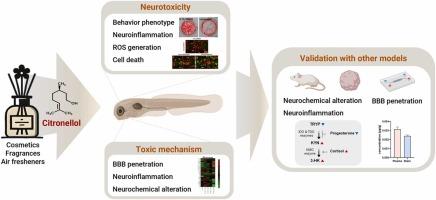犬尿氨酸转化为3-羟基犬尿氨酸所致香茅醇的神经毒性作用
IF 11.3
1区 环境科学与生态学
Q1 ENGINEERING, ENVIRONMENTAL
引用次数: 0
摘要
香茅醇广泛用于消费品,包括化妆品、香水和家居用品。然而,尽管被认为是一种相对安全的化学品,但根据产品含量,与接触高浓度香茅醛有关的健康影响和毒性机制仍未得到充分了解。本研究旨在通过行为学和组织学分析来分析香茅醇对斑马鱼幼鱼的神经系统影响,并阐明其体内神经毒性的机制。斑马鱼幼虫暴露于香茅醛(2、4和8 mg/L)可诱导一系列神经毒性作用,包括运动障碍、焦虑样行为、氧化应激、炎症反应和脑细胞凋亡。此外,暴露于香茅醇会破坏血脑屏障(BBB)的完整性,使炎症细胞浸润到大脑中。犬尿氨酸(KYN)对神经毒性代谢物3-羟基犬尿氨酸(3-HK)的代谢增加,并伴有神经类固醇水平的改变,包括孕酮和异孕酮的减少,以及皮质醇的升高,进一步维持了神经毒性作用。在口服给药(345、690和3450 mg/kg)的小鼠模型和暴露于香茅醇(1、10和100 μM)的人脑类器官中也观察到类似的代谢失调,这表明了物种间的保守机制。值得注意的是,用斑马鱼、老鼠和大脑芯片系统进行的实验证实,香茅醛穿过血脑屏障,在大脑中积累。总的来说,我们发现了一种新的神经毒性途径,包括KYN到3-HK的代谢途径、氧化应激和神经炎症,强调了长期暴露于香橼罗的潜在风险。本文章由计算机程序翻译,如有差异,请以英文原文为准。

Neurotoxic effects of citronellol induced by the conversion of kynurenine to 3-hydroxykynurenine
Citronellol is widely utilized in consumer products, including cosmetics, fragrances, and household items. However, despite being considered a relatively safe chemical, the health effects and toxicity mechanisms associated with exposure to high concentrations of citronellol, based on product content, remain inadequately understood. Here, we aimed to analyze the neurological effects of citronellol in zebrafish larvae using behavioral and histological analyses and elucidate the mechanisms underlying its neurotoxicity in vivo. Exposure to citronellol (2, 4 and 8 mg/L) in zebrafish larvae induced a range of neurotoxic effects, including locomotor impairments, anxiety-like behaviors, oxidative stress, an inflammatory response, and apoptosis in the brain. Additionally, citronellol exposure compromised the blood-brain barrier (BBB) integrity, permitting the infiltration of inflammatory cell into the brain. Neurotoxic effects were further sustained by increased kynurenine (KYN) metabolism to the neurotoxic metabolite 3-hydroxykynurenine (3-HK), accompanied by altered neurosteroid levels, including reduced progesterone and allopregnanolone, and elevated cortisol. Similar metabolic dysregulation was observed in mouse models following oral administration (345, 690 and 3450 mg/kg) and in human brain organoids exposed to citronellol (1, 10 and 100 μM), suggesting conserved mechanisms across species. Notably, experiments using zebrafish, mice and brain-chip systems confirmed that citronellol crosses the BBB and accumulates in the brain. Overall, we identified a novel neurotoxic pathway involving the KYN to 3-HK metabolic pathway, oxidative stress, and neuroinflammation, underscoring the potential risks of prolonged citronellol exposure.
求助全文
通过发布文献求助,成功后即可免费获取论文全文。
去求助
来源期刊

Journal of Hazardous Materials
工程技术-工程:环境
CiteScore
25.40
自引率
5.90%
发文量
3059
审稿时长
58 days
期刊介绍:
The Journal of Hazardous Materials serves as a global platform for promoting cutting-edge research in the field of Environmental Science and Engineering. Our publication features a wide range of articles, including full-length research papers, review articles, and perspectives, with the aim of enhancing our understanding of the dangers and risks associated with various materials concerning public health and the environment. It is important to note that the term "environmental contaminants" refers specifically to substances that pose hazardous effects through contamination, while excluding those that do not have such impacts on the environment or human health. Moreover, we emphasize the distinction between wastes and hazardous materials in order to provide further clarity on the scope of the journal. We have a keen interest in exploring specific compounds and microbial agents that have adverse effects on the environment.
 求助内容:
求助内容: 应助结果提醒方式:
应助结果提醒方式:


